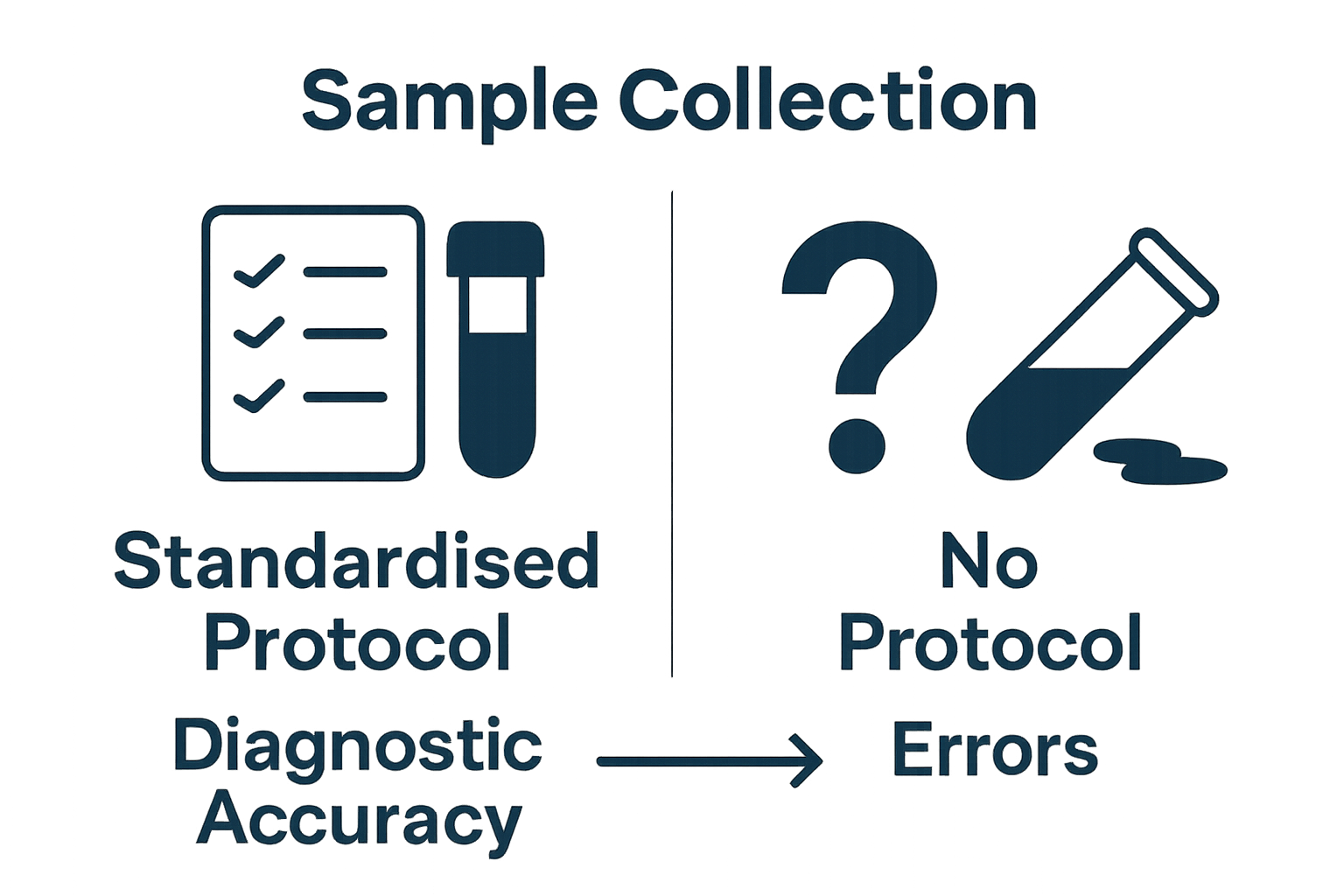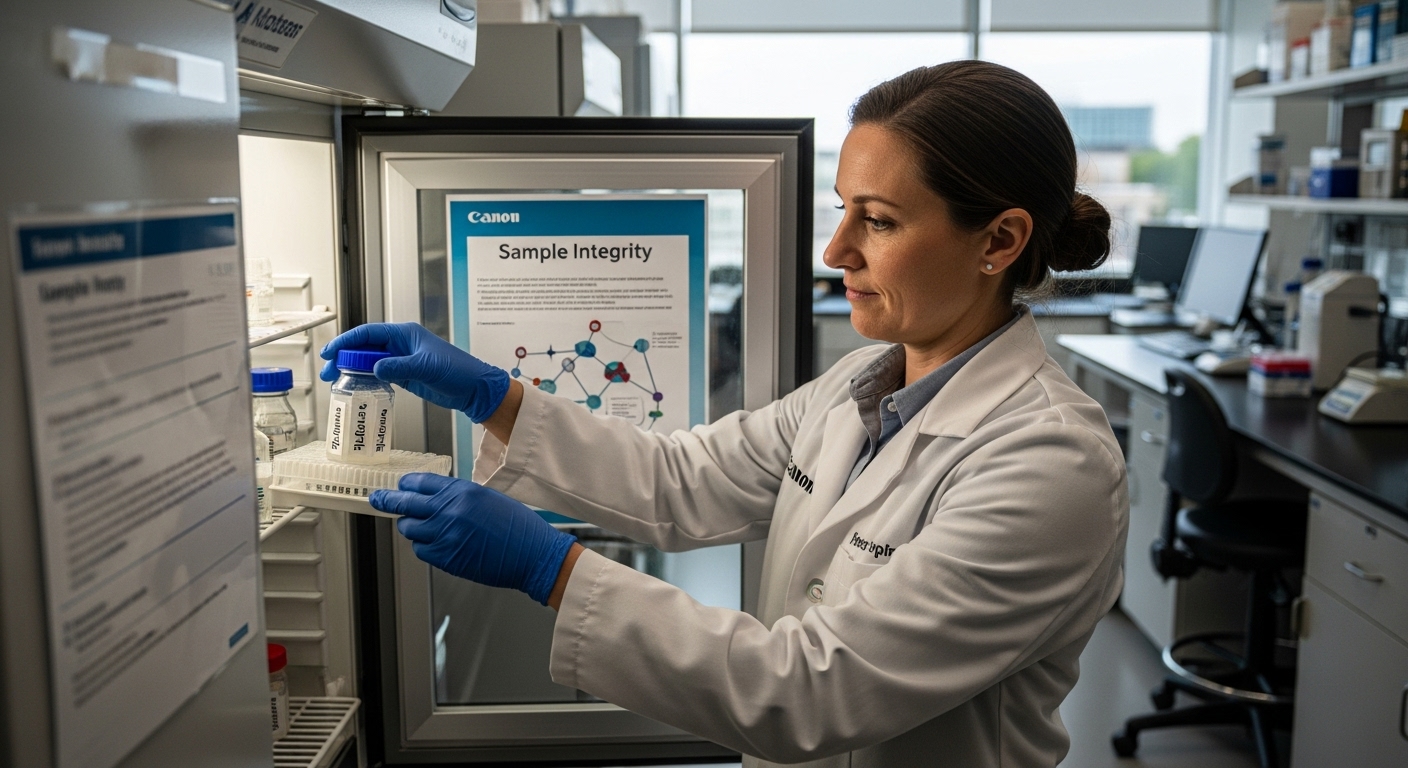Sample collection protocols are the unsung heroes behind every trustworthy medical test, quietly keeping hospitals and labs running smoothly day after day. Think about this. Even the tiniest error in specimen handling can increase the risk of misdiagnosis exponentially. Yet most people never realise how these detailed procedures turn chaotic samples into reliable results. The real surprise is that the paperwork behind the process is just as critical as the science itself.
Table of Contents
- Defining Sample Collection Protocol: A Fundamental Overview
- The Importance Of Sample Collection Protocol In Healthcare
- How Sample Collection Protocol Ensures Accurate Results
- Key Components Of An Effective Sample Collection Protocol
- Real-World Applications Of Sample Collection Protocol
Quick Summary
| Takeaway | Explanation |
|---|---|
| Standardise collection protocols | Consistent procedures ensure accurate and comparable results in diagnostics and research. |
| Maintain specimen integrity | Proper handling, temperature control, and swift processing are vital for reliable samples. |
| Prevent diagnostic errors | Clear guidelines reduce variability and potential mistakes in sample collection and analysis. |
| Essential documentation is critical | Detailed procedures guarantee transparency and reproducibility in sample management. |
| Support public health initiatives | Reliable data from standardised collection assists in monitoring and managing health trends effectively. |
Defining Sample Collection Protocol: A Fundamental Overview
A sample collection protocol represents a structured, standardised approach for obtaining, preserving, and managing biological specimens across medical, research, and diagnostic settings. The Health Research Authority defines these protocols as comprehensive guidelines ensuring precise and consistent methodology for specimen handling.
Core Components of Sample Collection Protocols
Sample collection protocols encompass multiple critical elements designed to maintain specimen integrity and research validity. These fundamental components include:
- Specimen Type Identification: Determining the specific biological material required (blood, urine, tissue)
- Collection Equipment Specifications: Selecting appropriate sterile containers and collection tools
- Patient Preparation Guidelines: Establishing pre-collection procedures like fasting or medication restrictions
The ultimate goal is standardisation, which minimises variability and ensures reproducible results across different contexts. Our guide to at-home phlebotomy offers additional insights into professional specimen collection techniques.
Importance of Standardised Procedures
Standardisation in sample collection prevents potential errors that could compromise diagnostic accuracy. By establishing clear, repeatable steps, healthcare professionals can:
- Reduce contamination risks
- Ensure consistent sample quality
- Enable reliable comparative analysis
- Maintain patient safety protocols
Accurate sample collection is not merely a technical procedure but a critical scientific methodology that underpins medical research, clinical diagnostics, and personalised healthcare strategies. The precision of these protocols directly influences the reliability of subsequent laboratory analyses and medical interpretations.

The Importance of Sample Collection Protocol in Healthcare
Sample collection protocols are fundamental pillars of modern healthcare, serving as critical mechanisms for ensuring diagnostic accuracy, patient safety, and effective medical research. The UK Health Security Agency emphasises that standardised procedures are essential for maintaining high-quality medical standards.
Diagnostic Precision and Patient Outcomes
Healthcare professionals rely on meticulously collected samples to diagnose, monitor, and treat various medical conditions. Precise sample collection directly influences medical decision-making, impacting patient treatment strategies. When samples are collected inconsistently or improperly, the potential for misdiagnosis increases exponentially. Explore our comprehensive guide to at-home blood sampling for understanding modern specimen collection techniques.
The implications of sample collection protocols extend beyond individual patient care, encompassing broader healthcare objectives:
- Enabling accurate disease tracking
- Supporting epidemiological research
- Facilitating personalised medical interventions
- Reducing healthcare system inefficiencies
Risk Mitigation and Quality Assurance
Robust sample collection protocols serve as critical safeguards against multiple potential risks in healthcare settings. These protocols minimise:
- Specimen contamination
- Incorrect sample identification
- Compromised sample integrity
- Potential cross-infection scenarios
By implementing stringent collection methodologies, healthcare institutions can significantly reduce errors that might compromise patient safety and clinical research integrity.
The meticulous approach ensures that every biological specimen represents a reliable data point in understanding patient health, supporting evidence-based medical practices and advancing scientific understanding.
How Sample Collection Protocol Ensures Accurate Results
Accurate medical diagnostics fundamentally depend on precise sample collection procedures that maintain specimen integrity from collection through analysis. The NHS Cervical Screening Programme underscores the critical nature of standardised collection techniques in producing reliable diagnostic outcomes.
Preserving Biological Sample Integrity
Maintaining the chemical and biological characteristics of collected specimens requires meticulous attention to multiple environmental and procedural factors. Temperature control, handling techniques, and immediate processing represent crucial elements in preserving sample quality. Learn more about preparing for accurate phlebotomy to understand these nuanced considerations.
Key factors influencing sample integrity include:
- Precise timing of specimen collection
- Appropriate storage temperature
- Minimising exposure to external contaminants
- Using validated collection equipment
- Rapid transportation to analysis facilities
Preventing Diagnostic Errors
Comprehensive sample collection protocols serve as critical defensive mechanisms against potential diagnostic errors. These structured guidelines help healthcare professionals:
- Standardise collection methodologies
- Reduce human error risks
- Ensure consistent sample quality
- Create reproducible testing conditions
- Maintain traceability of biological specimens
By implementing rigorous protocols, medical professionals transform sample collection from a simple procedural task into a sophisticated scientific process that directly impacts patient care and medical research outcomes. The precision embedded in these protocols represents a fundamental cornerstone of modern diagnostic medicine, enabling healthcare systems to deliver increasingly accurate and personalised medical interventions.

Key Components of an Effective Sample Collection Protocol
An effective sample collection protocol represents a comprehensive framework that systematically addresses every aspect of biological specimen management. The UK Environment Agency emphasises the critical importance of thoroughly documented sampling procedures that guarantee data reliability and scientific integrity.
Essential Documentation and Planning
Comprehensive documentation forms the backbone of a robust sample collection protocol. This documentation must meticulously outline every procedural detail, ensuring transparency and reproducibility. Explore our comprehensive guide to at-home blood sampling for understanding modern documentation practices.
Key documentation requirements include:
- Detailed description of sample type
- Precise collection methodology
- Equipment specifications
- Personnel qualifications
- Expected sample handling procedures
Technical and Procedural Specifications
Technical specifications transform theoretical guidelines into practical, executable procedures. These specifications address multiple critical dimensions of sample collection:
- Sterilisation protocols for collection equipment
- Temperature control mechanisms
- Transportation guidelines
- Sample storage conditions
- Preservation techniques
By establishing clear, unambiguous technical parameters, healthcare professionals can minimise variability and ensure consistent, high-quality specimen collection across diverse clinical and research environments. The intricate details embedded within these protocols serve as a comprehensive roadmap, guiding practitioners through complex biological specimen management processes with precision and scientific rigour.
The table below summarises the key components of an effective sample collection protocol, offering a clear overview of essential documentation and technical specifications involved.
| Component | Description |
|---|---|
| Sample Type Identification | Specifies biological material required (e.g., blood, urine, tissue) |
| Collection Equipment Specifications | Details sterile containers and collection tools used |
| Patient Preparation Guidelines | Outlines pre-collection requirements such as fasting or medication restrictions |
| Documentation | Comprehensive records of procedures, equipment, and personnel qualifications |
| Technical Specifications | Sterilisation, temperature control, transportation, storage, and preservation techniques |
Real-World Applications of Sample Collection Protocol
Sample collection protocols transcend theoretical frameworks, playing pivotal roles across diverse scientific and medical domains. Public Health England demonstrates how structured sampling methodologies are fundamental to understanding complex healthcare challenges and epidemiological dynamics.
Clinical Diagnostics and Medical Research
Modern medical diagnostics rely extensively on precisely collected biological specimens. These protocols enable healthcare professionals to track disease progression, develop targeted treatments, and conduct groundbreaking research. Check out our comprehensive guide to at-home phlebotomy to understand practical implementation of these protocols.
Critical applications in clinical settings include:
- Early disease detection
- Monitoring chronic conditions
- Personalised treatment development
- Tracking genetic markers
- Evaluating treatment effectiveness
Epidemiological Surveillance and Public Health
Sample collection protocols are instrumental in managing public health challenges, providing structured methodologies for tracking and understanding widespread health phenomena:
- Monitoring infectious disease spread
- Conducting population health surveys
- Developing vaccination strategies
- Tracking emerging health trends
- Identifying potential epidemic risks
These protocols transform raw biological data into actionable insights, enabling healthcare systems to respond proactively to complex medical challenges. By establishing standardised collection methods, researchers and medical professionals can generate reliable, comparable data that drives scientific understanding and improves patient outcomes across diverse healthcare landscapes.
The following table contrasts clinical diagnostics and public health applications to clarify how sample collection protocols are utilised in different healthcare contexts.
| Application Area | Key Focus | Typical Uses |
|---|---|---|
| Clinical Diagnostics | Individual patient analysis | Disease diagnosis, monitoring, personalised treatment, genetic marker tracking |
| Medical Research | Advancing scientific understanding | Evaluating treatments, tracking disease progression, study validity |
| Epidemiological Surveillance | Population-level health trends | Disease spread monitoring, vaccination planning, epidemic risk identification |
| Public Health | Health system response and intervention | Population surveys, emerging trend tracking |
Experience True Confidence in Your Health Data with Lola Health
You have just learned how vital sample collection protocol is for accurate test results and reliable medical advice. Inconsistency, contamination, or improper handling can lead to uncertainty and stress, especially when your wellbeing is on the line. Lola Health understands these concerns and addresses them with unwavering commitment. Our at-home and clinic blood testing services are strictly aligned with best-in-class sample collection standards, providing you assurance at every step. NHS-standard, UKAS-accredited laboratories and certified medical professionals safeguard your samples, so you can trust each result completely.

Take control of your health journey now. Visit Lola Health to order your at-home blood test, book a seamless phlebotomy appointment, and access fast, expertly reviewed results.
Discover peace of mind knowing your care is built on evidence, precision, and compassion. Learn more about our at-home blood sampling process and what to expect for phlebotomy preparation. Your accurate health insights await—choose Lola Health today.Frequently Asked Questions
What is a sample collection protocol?
A sample collection protocol is a structured and standardised approach for obtaining, preserving, and managing biological specimens in medical, research, and diagnostic settings. It ensures consistency and accuracy in specimen handling.
Why is standardisation important in sample collection?
Standardisation in sample collection is crucial as it minimises variability, reduces contamination risks, and ensures consistent sample quality, directly impacting the reliability of diagnostic tests and research outcomes.
What are the core components of an effective sample collection protocol?
Key components include specimen type identification, collection equipment specifications, patient preparation guidelines, comprehensive documentation, and technical specifications governing the sample collection process.
How do sample collection protocols prevent diagnostic errors?
Sample collection protocols minimise diagnostic errors by standardising methodologies, reducing human error, ensuring consistent sample quality, and maintaining traceability of biological specimens for accurate lab analysis.


